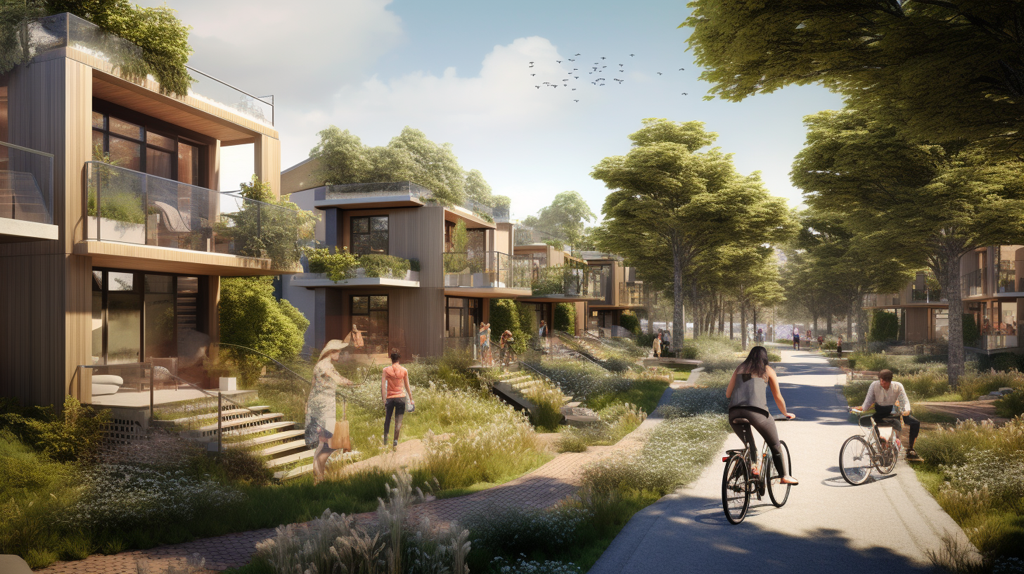Circular buildings: the technology is there, but now we need the revenue model

Reusing materials and easily moving houses. Circular construction requires a new mindset. To make the transition successful, not only construction but also the people and the economy behind it must change.
Is the large housing district on the outskirts of the city no longer needed after 20 years? Then the houses are moved to another place. Also, roads are easily rolled up and out again. Are there too many office buildings? Then, we easily transform the properties into student or elderly homes. The built environment will become much more flexible in the future, outlines Daan Schraven, associate professor at TU Delft in the field of new economics in the built environment.
"The street scene now hardly changes in a hundred years. That will soon be different. The city of the future is diverse and adapts easily," Schraven says. He sees an important role in modular construction. "We often need part of the buildings only temporarily. By building modularly, we can easily move the houses around."
In addition, he sees opportunities for buildings to remain much longer. "If we don't want to tear down buildings and build them up again, we have to make sure they are multifunctional. For instance, it makes sense to think about the possibility of turning an office building into student housing when it is constructed. Consider, for example, sufficient connections for water and electricity. In addition to these two extreme forms, there are of course many intermediate solutions. That makes the cities of the future adaptable."
Economic feasibility
Schraven's work at TU Delft focuses on the new economy of the built environment. The expert is convinced that the circular transition in construction is coming. After all, the technologies already exist. The problem is the economic feasibility. For now, developments are slow. Figures from the Centraal Bureau voor de Statistiek (CBS) show that circularity in the Dutch economy has barely increased since 2014. So far, only 13 percent of materials are being reused. "We must ensure that the new technologies and process innovations also remain. For this, it must be economically convenient to work according to the new standards, even if there is no more subsidy from the government in the future. In short, there must be a good business model for circular construction."
Schraven and his research group are looking at new value models for the circular economy. This involves not only the financial side but also the social side. "In recent years, the government has made a lot of extra investments when it comes to sustainability. Now we see that there is a pushback coming. When it comes to climate policies, society is calling for greater consideration of the least fortunate.." Such developments are significant in the complete process of innovation and change, according to the associate professor. In his research, implementation is at least as important as technology. "The implementation ultimately creates the societal impact."
Collaboration strengthens transition
Schraven is actively involved in 4TU.Bouw, a collaboration between the architecture faculties of the four technical universities in the Netherlands. Within this collaboration, so-called Domain Acceleration Teams (DAT) have been set up around various themes. One of the DATs focuses on Circularity and Sustainability. The team initiates new research and is also the point of contact for people from the industry, the Top Sectors, and the government. "It is a team of people looking at circularity and sustainability in construction from a social science perspective. Because there are experts with different backgrounds on the team, we have a broad field of view, and we reinforce each other."
The DAT's agenda on circular construction highlights academic concerns and challenges. This agenda was important input for the TKI Bouw en Techniek, the Top Consortium for Knowledge, and Innovation in Construction. In it, various challenges, including economic feasibility, are examined. "As DAT, we want to show the necessity of the transition. Not by focusing on the negatives but mainly by looking at the opportunities. Building a community is important in this. In this, there is room for science, of course, but also for the circle around it, such as entrepreneurs," Schraven explains.
Old building as donor
Within the DAT, he is working on the project "Intrinsically Circular”. The starting point is to use an old building as the basis for a future building. "To close the loop and not produce waste, we want to reuse an old building for new construction completely. The new building will still require some additional materials, for example, to make the building strong enough," he explains.
This requires that the architect - who designs the new building - and the demolition company - who demolishes the old building - communicate well with each other. The architect can then already consider possible demolition and reuse of parts in the design. That hardly ever happens to date, Schraven knows. "In this project, we are trying to create tools to make the conversation between the different parties go well."
A wave of change
With workshops and conferences, the DAT Circularity and Sustainability aims to connect universities. "It is important that we have a joint plan to move the research towards a circular economy forward, all from our expertise. Then we can also involve industry to achieve implementation and impact." Schraven sees workshops and conferences as one way to ensure this.
His goal? "Now you see the circular transition is all little hot air balloons. One is launched and then quickly punctured again, for example, because there are objections to financing possibilities or scaling up. It must - partly because of all the research and projects - become a wave motion. Circular building must be a no-brainer. So that the government no longer drives the transition but comes from the people themselves. That people themselves choose sustainable and circular construction because it is good for the planet and society, but above all because it just works."



